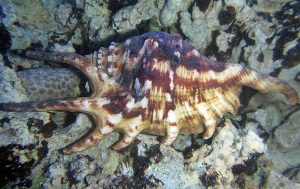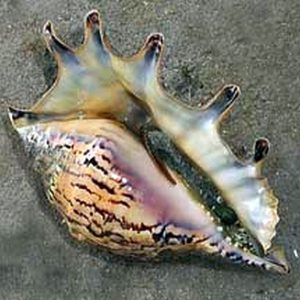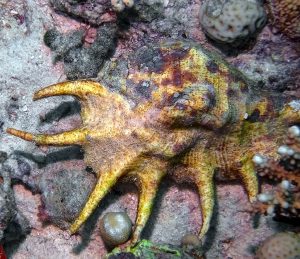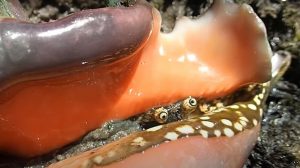The Spider Conch (Lambis lambis) is a large species of sea snail that is widespread in Indo-West Pacific Oceans.
The Spider Conch is a true conch in the Strombidae family that is found in the shallow waters of reef flats, mangrove flats, and among coral rubble bottoms of their range. Spider Conchs are commonly found in colonies around growths of fine red algae at low tide depth levels, to a depth of 16 feet or more.
The Spider Conch has a large, heavy, powerfully built shell, with a flared outer lip and six long, hollow, protruding horns that resemble
spiders legs (i.e. its common name). They have a “trunk” like mouth and eyes on long stalks that can move independently.
Juvenile snails look like large Volutes and lack the long spines that adults posses.
The external shell color of the Spider Conch is highly variable but is usually a white or cream color splotched with patches of brown, purple, or bluish black. The upper side is usually well encrusted and blends into the surrounding sea floor. The glazed interior can be orange, pink, or purple.
Although Lambis lambis can grow up to 12 inches (including appendages) across; their average size is about 9 inches. Sex can be determined by the size and direction of their marginal hollow “legs”. In males, the three forwardmost legs are short and bent towards the rear. In females, the legs are longer and dorsally recurved.
Like other conch snails, the Spider Conch hops using the knife like operculum at the tip of its long muscular foot. The spider like spines on the shell are believed to improve stability and prevent the snail from toppling over as it hops along the substrate.
The Spider Conch is reef safe and is best housed in a reef aquarium of at least 125 gallon capacity with algae encrusted live rock and large amounts of deep sandy substrate for them to sift through and feed among. They spend a good amount of time cleaning and sifting the sand bed and can disappear under the substrate for extended periods. Although their sand sifting does not harm beneficial sand micro fauna or disturb bacterial micro zones in the sand bed, Spider Conchs have a tendency to crawl on the live rock and could disturb loose rocks and coral frags in a reef system. Avoid housing them with predatory fish species.
The Spider Conch has been bred under controlled conditions however, the veligers are extremely difficult to raise. In 2010, after about four months of maintenance, a pair exhibited mating behavior and laid a mass of filamentous eggs. In the middle of the day, the male and female positioned face to face and copulated for about a 3 to 4 hour period. Two weeks after mating, several brown, adhesive, thread like masses of clindrical egg filaments were deposited onto the substrate. For three days, the female remained close to the spawn, partially or entirely covering it with her shell until the eggs hatched out. After 5 days, the small veligers had a well defined digestive system and were swimming close to the surface. Unfortunately, they did not survive to adulthood. More on their breeding can be found HERE.
In their natural habitat, Spider Conchs feed on red hair algae, film algae, red algae, detritus, and many other cyano species. They are excellent cleaners and substrate stirrers. In a mature reef aquarium with plenty of deep, sandy substrate and live rock; they will eat excess algae and detritus. Sinking algae pellets and spirulina can be fed to augment what they find in the tank to eat.
The Spider Conch (Lambis lambis) is a great addition to your tank if you are looking to add an invertebrate that is beautiful, unique, and beneficial. They are available to tropical fish keeping enthusiasts from specialty fish shops and online from a variety of retailers at reasonable prices. Adult 4″ (6″ overall) specimens are priced at around $20.00.
Minimun Tank Size: 125 gallons
Aquarium Type: Established Reef or FOWLR
Care Level: Easy
Temperament: Peaceful
Aquarium Hardiness: Hardy
Water Conditions: 74-80°F, dKH 8 to 12, pH 8.1-8.4, sg 1.023-1.025
Max. Size: 12″
Color Form: Orange, Cream, White, Yellow, Purple
Diet: Omnivore
Compatibility: Reef Compatible
Origin: Indo West Pacific
Family: Strombidae
Lifespan: Over 4 years
Aquarist Experience Level: Beginner





